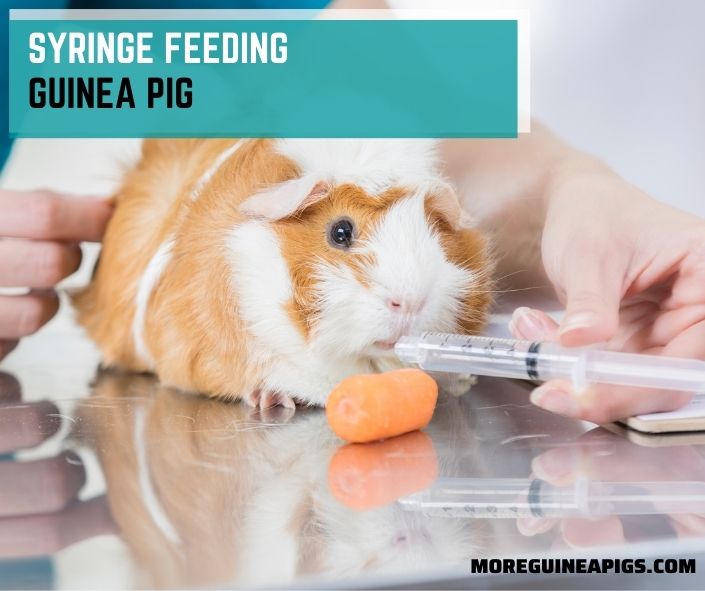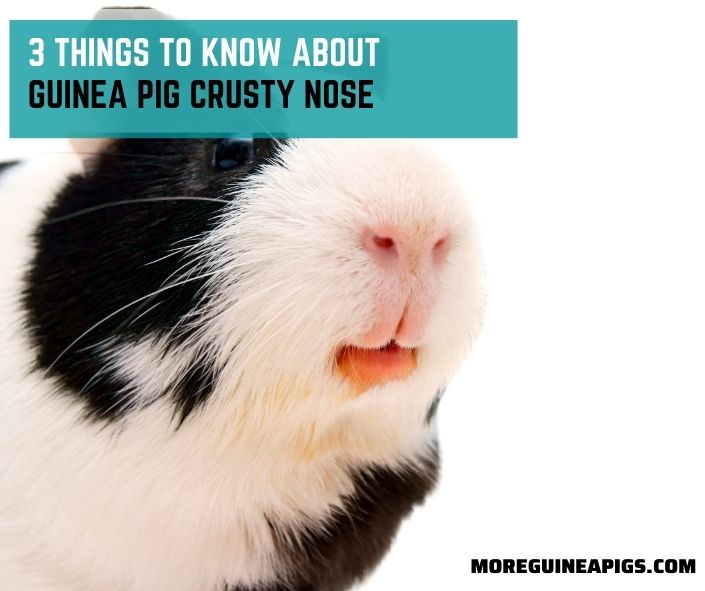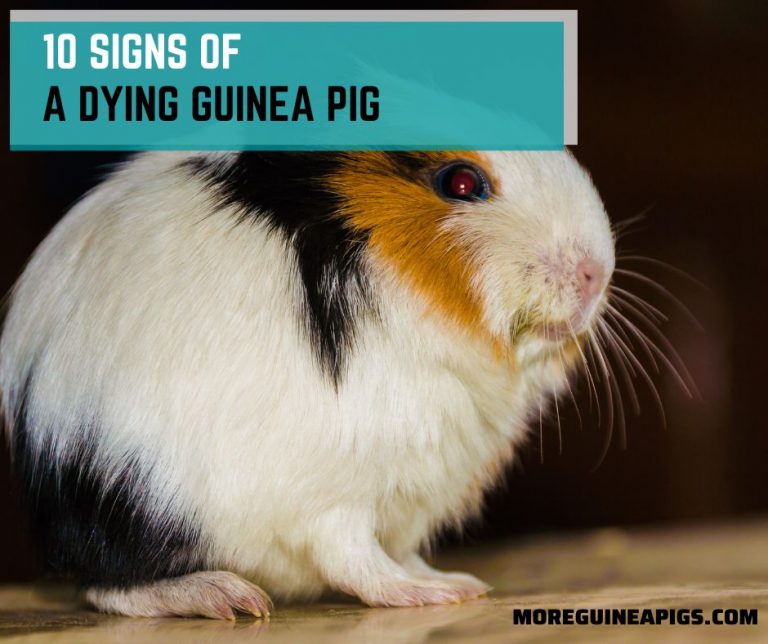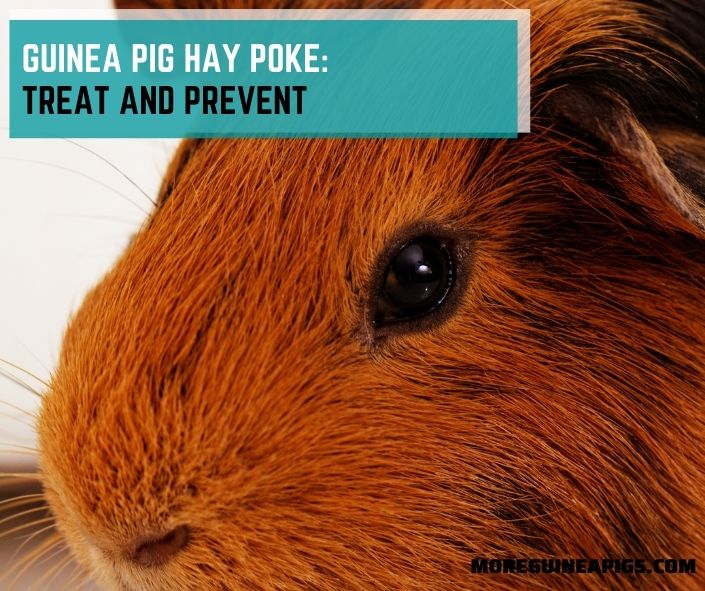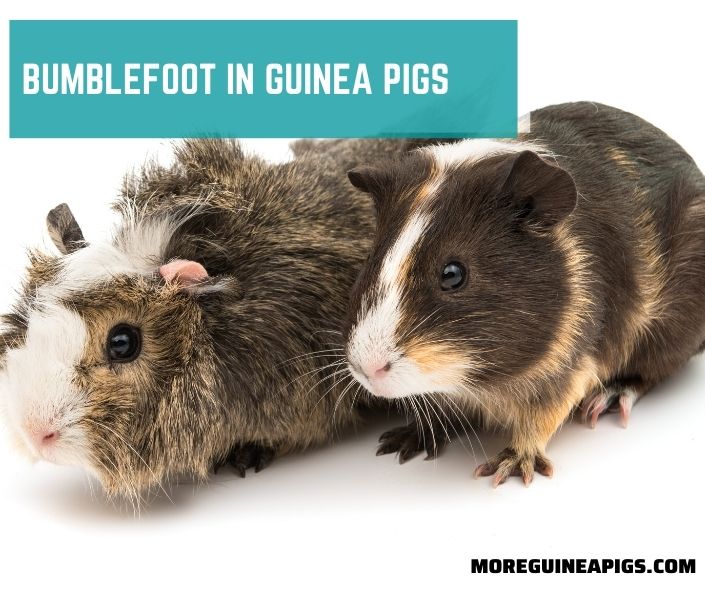Syringe Feeding Guinea Pig: The Most Complete Guide
We all know what syringe feeding is. Perhaps you did syringe feed a household pet before, or someone did it in your presence.
Syringe feeding a guinea pig is like with any other pet. More often, people syringe feed orphaned piggies, which is common in guinea pig rescue centers.
Syringe feeding is not only beneficial to orphaned baby guinea pigs; it’s an imperative approach when your pet is unable to eat too. Still, some other circumstances may require you to go for syringe feeding.
This article provides an in-depth exploration of conditions about syringe feeding guinea pigs, what to syringe feed, and how to go about the process. Read through for more!
When Do You Need to Syringe Feeding Guinea Pig?
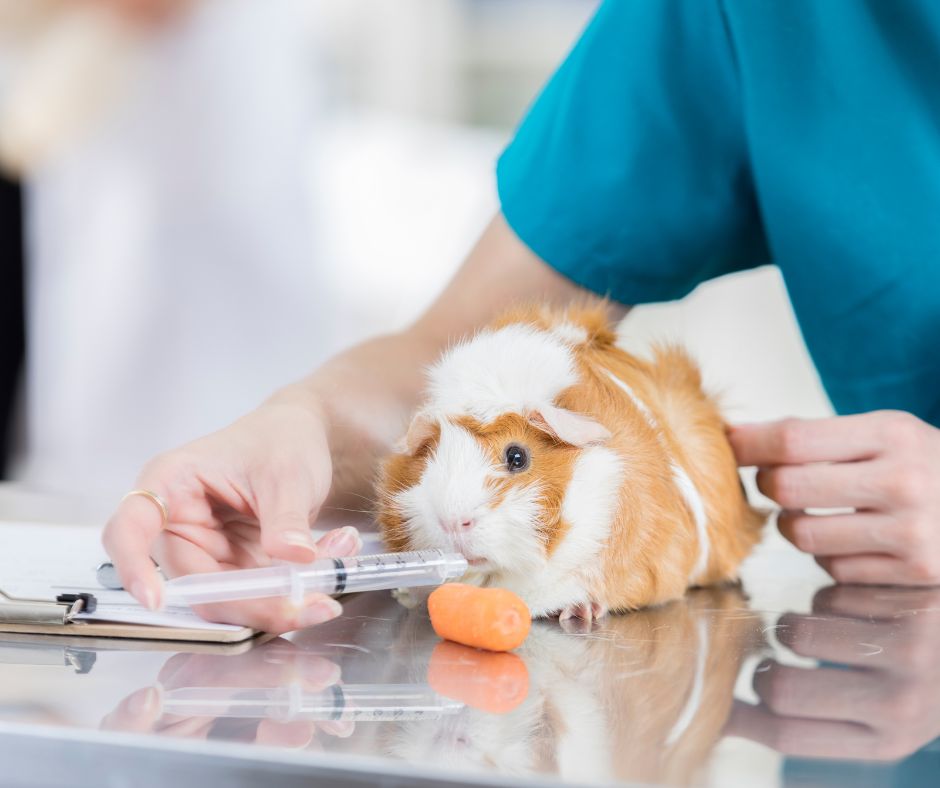
In syringe feeding, you administer food and water to the mouth of your guinea pig using an oral syringe. It’s a standard method of nutritional support when your pig is unwilling or unable to eat independently.
Various situations can result in guinea pigs requiring syringe feeding, for instance, ill health of the pig, dental health problems, rejection of the pups by the mother (and they’re unable to eat themselves), or the pig is recuperating from surgery.
Moreover, if your guinea pig has a broken jaw, syringe feeding will be necessary. You may also want to assist your elderly guinea pig in feeding if it’s not maintaining weight.
The syringe feeding for guinea pigs is cheap and pretty easy to do. It’s a short-term feeding but effectively saves your pet’s life when experiencing a health problem or decreased appetite.
Your pet will get some nutrients, calories, and energy to fight health issues. Syringe feeding also prevents continued weight loss and keeps the gut moving, preventing gut stasis.
What Can You Syringe Feed A Guinea Pig?

Syringe feeding can help to alleviate your guinea pig’s appetite quite quickly. It’s important to consider that the food you’re giving is well-balanced. It should be rich in nutrients and calories that your guinea pig requires.
Liquid foods are ready to feed, but those in solid form require smashing or blending with the addition of an appropriate liquid, e.g., water, milk, etc. An oral syringe (with needle absent, of course) is what you require for syringe feeding.
Look for 1ml syringes online, or you can get them from your veterinarian. A syringe exceeding 1ml may release a large volume of food and put the pig at risk of aspiration or choking.
Ensure the liquid food you prepare is super thick but not overly thick not to get into the syringe.
Tip: If you don’t have a syringe, you can use a pet nursing bottle like this from Amazon or opt for spoon-feeding if the pet accepts it.
Products Can Be Used For Syringe Feeding Guinea Pig
There are many food options to syringe feed your pet piggy, including liquidized veggies and greens, vegetable-pellet mixture, smoothies or juices, pumpkin pellet mash, etc.
You may want to liquidize your guinea pig’s favorite herbs, veggies, or fruits. All these foods are alternatives to commercial food products, and you can cheaply prepare them at home.
However, if you don’t have time to make a DIY liquid food, going for commercial products is also a wise option. Below are different products options that you can use for syringe feeding your guinea pig.
Oxbow Critical Care Herbivore-FINE GRIND.
It’s a nutritionally complete and highly versatile powdered formula suitable for guinea pigs recovering or during an emergency.
Critical care herbivore-fine grind is highly digestible and palatable and comprises a stabilized form of vitamin C. Its smaller particle size gives it a bonus as an assist-feeding formula for guinea pigs. This product has the same nutrition content as Critical care herbivores, although finer particle size. The former is a more refined version of the latter.
Smoothly passes through a syringe, and it helps support the immune system and muscles gastrointestinal health, maintain healthy body weight, and improve appetite.
It’s richly supplied with fiber that enhances gastrointestinal motility. Its powder easily mixes with water to generate a formula that can pass through a syringe of 1ml (1cc).
You can mix Emeraid herbivore with critical care herbivore fine grind or another suitable product within your reach for longer use. The vet can advise you on the best combinations.
EMERAID Sustain HDN Life Saving Nutrition for Herbivores
Supreme Petfoods Recovery Plus
- It is the best idea for guinea pigs since it lacks artificial colorants or added sugars—a perfect product to use during times of reduced appetite, stress, or digestive sensitivity.
- Supreme petfoods recovery will provide nutritional support to your guinea pig and restore its nutritional well being. It helps to revive natural feeding.
Supreme Petfoods Science Selective Recovery Plus
Tip: Follow the manufacturer’s instructions from each product to prepare the formula. Moreover, avoid feeding your guinea pig cereal-based products coated with sugar and honey. Also, exclude foods like mashed dried beans, mushrooms, avocado, etc.
Can I Syringe Water to My Guinea Pig?
Yes, if your piggy can’t drink water by itself, you can feed it through a syringe. Locate the syringe at the corner of the piggy’s mouth and not in the center.
Shooting water in the center of the mouth deliberately or unintentionally risks your pet’s life. Such water administration causes the pig to suffocate and can die in a matter of seconds.
Shoot a small amount of water at a time (about 1/3 ml) and observe the pig’s reactions. If you notice it shows signs of chewing, that tells you that the pig is absorbing the water. It’s a good indication.
4 Steps To Syringe Feed Guinea Pig
Syringe feeding a guinea pig is a matter of following the proper steps and showing discipline. It demands caution since you may aspirate and kill your pet in the process of trying to save its life.
But I’m not discouraging you from doing it; all you all need is to be confident and adhere to the guidelines.
When it comes to syringe feeding a guinea pig, always make sure you have the right ingredients and tools, prepare a recovery product, hold the pig rightfully, and embark on the feeding.

Gather the Ingredients And Tool
Ensure you have the right supplies with you to prevent unnecessary movement when feeding commences. You will require several 1cc syringes obtained from your vet or online.
Having a couple of syringes prevents one syringe overused as it can operate less smoothly, even if you sanitize it. It will definitely harden your work.
You will need a towel to wrap the pig. Alternatively, you can have another person help you hold the pig. The tissue will also help wipe the pig’s chin.
Make sure to work from a suitable height with you to control your pig; e.g., a worktop is convenient. Have a bowl and spoon with you to use to prepare a liquid diet.
12 Pack – 1ml Plastic Syringe with Measurement
Preparing A Recovery Product For Your Pet
The recovery products that work best for guinea pigs are Emeraid herbivore, science recovery foods, and OxBow critical care herbivore. Some homemade foods like ground fruits and veggies are also acceptable to use.
Follow the guidelines from the manufacturer (listed on the product’s pack) when preparing the formula. Observe the mixing instructions and prepare the volume of food required.
Avoid making a paste that is too watery since it contains fewer nutrients and may also increase choking risks. Please seek help from your vet if you’re unsure of the paste thickness to prepare.
You can also opt for safe, fresh food puree, including banana and blueberry pellet liquid formula, liquidized vegetables and brown bread, pumpkin pellet mash, etc.
Making your own critical care at home is as easy as ABC. A homemade formula can perfectly substitute commercial products as long as we use the ingredients in the right amounts and ensure the formula is not nutritionally deficient.
Handle And Hold the Piggy
What you need is for your guinea pig to eat comfortably from a syringe without risking its health. Ensure that the room/place you are working from is quiet and comfortable. When calmed and relaxed, your pet can eat quite well.
Please don’t hold the pig carelessly since you’re likely to stress it. Below is a safe way to restrain the pig.
- Wrap your guinea pig on a towel if you don’t have an assistant to help you. Place the towel on a table, or you can work from the floor if the pet is ‘flight risk’ but make sure you can work from that position.
- Place your guinea pig in the middle of the towel, gently tuck the towel under its chin, then fold it over the body from both sides, and have a swaddled, comfortable pet.
- Hold the guinea pig close to your body by gently tucking it against your side using your forearm.
- Hold the head with your index finger directly under the pig’s chin, and place the thumb at the base of the skull. Place the remaining fingers on the piggy’s chest to restrict it from moving forward.
Pet Guinea Pig Emergency Kit with Timothy Recovery Food
Ready to Start Syringe Feeding
Always allow the feed mixture (soak in warm water) to cool until about room temperature or lukewarm. Hot foods will burn their delicate mouth and also cause stomach upset. “Better being safe than sorry.”
Once you take a position where you and your guinea pig are comfortable, it’s time to start syringe feeding. Pull the feed mixture into the syringe.
Place the syringe into the pig’s mouth, and do it from the side such that the syringe’s tip goes behind the front teeth. It helps to prevent shooting the food straight down the pig’s throat, reducing the risks of choking.
Slowly, drip a small amount of the feed mixture (not more than half of the syringe) into the pet’s mouth. Your guinea pig should begin to swallow. When you think it’s ready, slowly slide the syringe again and give the other half.
Always ensure that your guinea pig is not eating quickly. Take it slowly and go with its pace. You shouldn’t be in a hurry when syringe feeding your piggy; it’s risky.
If you’re experienced, you may administer a whole 1ml at once, but exercise extreme caution to avoid aspiration.
Sometimes, you may have problems inserting the syringe into the mouth; in such a scenario, gently put your hand over the pet’s face with your fingers resting on either side of the mouth.
The pig will open its mouth enough to insert the syringe in. If your pet is small or weak and struggles to swallow food, give less than 0.3 ml of food mixture at once.
Tips
Something to remember is to keep your guinea pig hydrated even in the process of syringe feeding. Hence, for every 3-5ml of food formula, give 1ml of fluids, e.g., water.
Be extremely careful when syringe feeding any guinea pig. Go as slowly as possible to avoid choking issues. Take caution not to dispense food while your guinea pig is vocalizing. The paste may get into the respiratory system and increase aspiration risks.
You need to be patient, too, with this process. Syringe feeding can cost your time, it can be messy and frustrating, but calmness and persistence are needed.
Also, if your pet companion becomes dramatically distressed, you should proceed with syringe feeding until it’s calm and relaxed.
How Often Should You Syringe Feed A Guinea Pig?
How much and how often to syringe feed a guinea pig varies depending on its condition and age.
For instance, a guinea pig in significant discomfort and unable to swallow food may need a syringe feed of 3-5ml per feeding session and repeat feeding every 2-3 hours. Be sure to drip less than 0.5ml of the paste in one go.
If the pig is severely weak, aim to syringe feed about 2ml of food every 10-15 minutes and allow more time for swallowing before another drip.
Likewise, syringe as much fluids as the pig will take to help in hydration. It’s imperative to weigh your guinea pig daily to see if you’re syringe feeding enough food to maintain its weight.
Keep a record of the weight observed and the amount of food you give, together with the amount of fluid used.
If the pig is comfortable eating and chewing the syringe-fed foods, you can gradually wean it off syringe-feed and introduce hand/bowl feeding. But work with your vet to know what best foods to start with.
What If the Guinea Pig Refuses to Eat the Mixture?
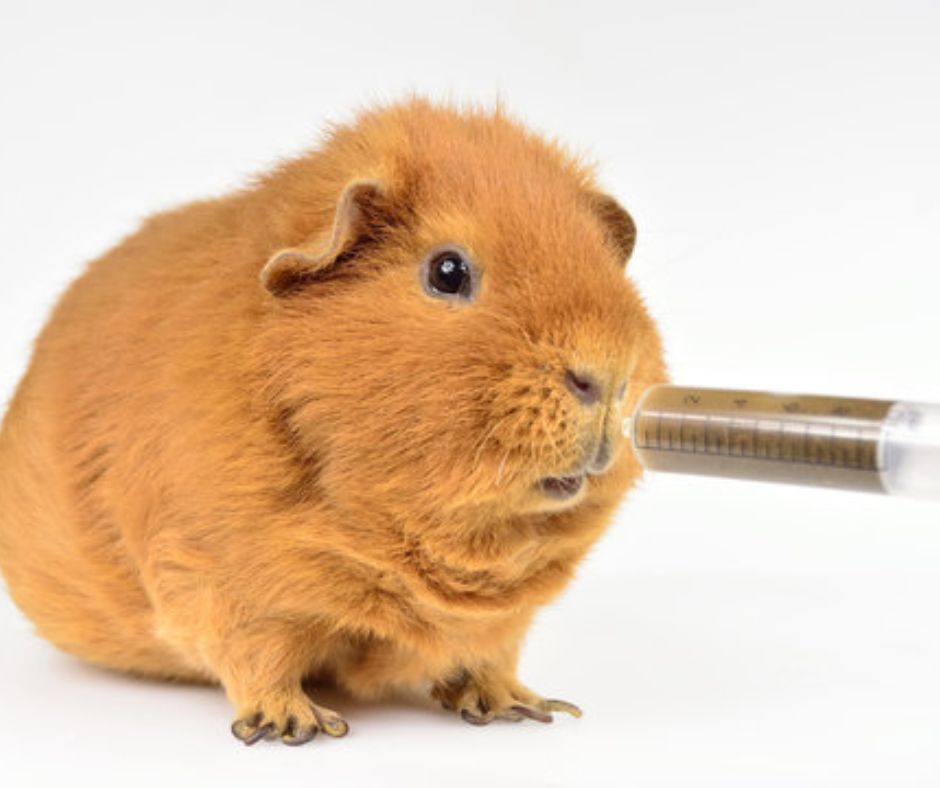
It’s not uncommon for guinea pigs to refuse to eat a syringe-fed food even after you attempt to prepare their favorite formula. It can be a frustrating and terrifying situation, especially since no one is ready to lose their pet.
The pig rejects foods of any kind, and the worst thing is to continue to lose weight. Please see your veterinarian as quickly as possible to have the pet checked up during such circumstances.
However, your animal pet may find a specific mixture unfavorable. You can try a different blend and observe the response. Stick to what the pig accepts, but the vet will help you if not any.
After medication or operation, your pig will recover slowly, and within a few days, it should start accepting food.
How Long Can Guinea Pigs Go Without Food?
Guinea pigs are one animal that requires chewing something more often. They frequently eat to keep their gut open. Is it possible by any means for guinea pigs to go without food?
Yes, healthy guinea pigs can survive for approximately 8-12 hours without food, although they are likely to develop intestinal issues. The pet may also be at risk of getting other health problems.
You shouldn’t keep your guinea pig hungry for more than 12 hours as this will lead to intestinal blockage, and your pet might even die. A healthy guinea pig can stay without water for 24 hours, but it’s still not recommended.
In Conclusion
Syringe feeding in guinea pigs is a typical life-saving technique. You aim to keep your animal pet alive, and its gut from closing down, hoping that it will soon be okay.
Guinea pigs not eating means that something is wrong. It could be due to bad teeth, broken jaw, ill health, etc.
There are many recovery foods options to feed unwell, weak, and recovering guinea pigs, including, Emeraid herbivore, Oxbow critical care, etc.
Likewise, exercise extreme caution when syringe feeding a guinea pig. That’s the only way to avoid aspiration or choking problems.
